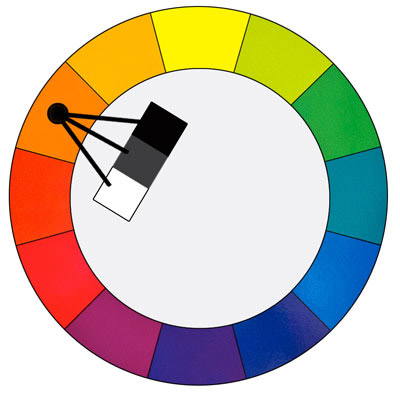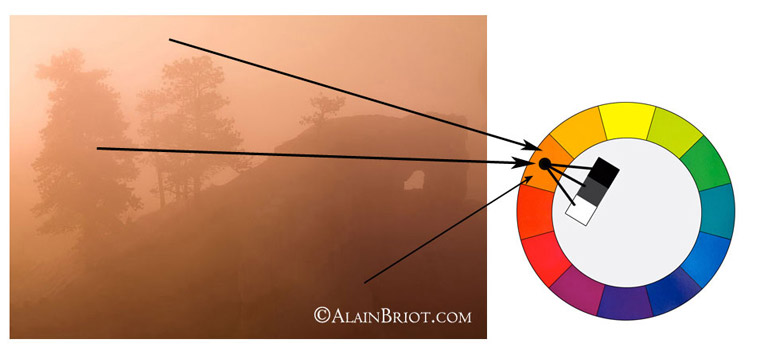Part 1 of 9: Monochromatic Color Harmony
In order to create a specific color palette for a photograph, colors need to be organized. This is done by using one of several color arrangements. These different color arrangements are called Color Harmonies. They are called harmonies because the goal of these arrangements is to create harmonious color palettes.
There are nine different color harmonies. In this series of essays, we are going to look at examples of all nine harmonies. In doing so I will go over what each harmony consists of and provide examples of each harmony.
2 – The Three Variables of Color
Color is influenced by three variables: hue, saturation and luminosity. To create a specific color harmony, all three variables of color need to be modified. This is done in the software, either in the raw converter or for a higher level of control, using layers in Photoshop.
Here is a short description of the three variables of color:
- Hue – refers to the name of a color. For example blue, red, yellow, etc.
- Saturation – which is also called chroma, is the intensity of a color. High saturation colors are bright and colorful while low saturation colors are less colorful and appear dull.
- Luminosity – which is also referred to as value, is the lightness or the darkness of a color. Any color can be made lighter or darker. In painting. this is achieved by adding black or white to a color. In photography, it is achieved by increasing or lowering the exposure of the image either in the camera or in the software. In a photograph, areas that receive a lot of exposure are more luminous than areas which received little exposure.
3 – Monochromatic Color Harmony
The first color harmony we are going to study is the Monochromatic color harmony.

A tint is a color to which white was added, a shade is a color to which black was added, and a tone is a color to which grey was added.
In a monochromatic color harmony, the hue stays the same in the entire image. Only the saturation and the luminosity of the color changes.
Very delicate effects can be created with this harmony because the use of a single color lends itself to subtlety and refinement in art.
4 – Example: Bryce Canyon Sunrise Fog
This photograph was taken at sunrise in Bryce Canyon National Park. There was a heavy layer of fog over the canyon. The sun was rising behind the fog, giving the fog an orange glow. The whole scene exhibited a natural monochromatic color harmony, the color being composed of variations of orange tones, some lighter, some darker, some more saturated and some less saturated.

- This color harmony is found frequently in nature on overcast, pre-dawn, or post-dusk lighting conditions
- Only 1 color is present but in luminosity and saturation levels
- This is a very effective and artistic harmony
- In this harmony, as with many aspects of art, less is more
- This harmony is minimalist by definition
6 – Continuing Your Studies
Color harmonies are one of the most important aspects of a personal style. If you are working on developing your style take a look at my just-released Personal Style Master Class Workshop on DVD. A FREE 20 pages ebook table of content is available. All you need to do is email me at alain@beautiful-landscape.com with the words ‘Master Class’ in the subject line and you will receive the link to the free eBook immediately.
Alain Briot
–
 About Alain Briot
About Alain Briot
Alain Briot creates fine art photographs, teaches workshops and offers DVD tutorials on composition, conversion, optimization, printing and marketing photographs. Alain is also the author of Mastering Landscape Photography. Mastering Photographic Composition, Creativity and Personal Style and Marketing Fine Art Photography. All 3 books are available from Amazon and other bookstores as well from Alain’s website.
You can find more information about Alain’s work, writings and tutorials as well as subscribe to Alain’s Free Monthly Newsletter on his website at http://www.beautiful-landscape.com To subscribe simply go to http://www.beautiful-landscape.com and click on the Subscribe link at the top of the page. You will have access to over 40 free essays by Alain, in PDF format, immediately after subscribing.
Alain welcomes your comments on this essay as well as on his other essays. You can reach Alain directly by emailing him at alain@beautiful-landscape.com
Text, diagrams and photographs copyright © Alain Briot 2012. All rights reserved
Subscribe to Reflections:
Enter your email address: Delivered by FeedBurner
dera sir,it was very useful note on colour harmony.
thnaking u.
with prayers
dr.raghavan
12-04-2012